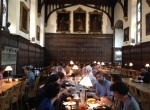Coin Hoarding in the Roman Empire Conference
Organized within the long-term Oxford Roman Economy Project, the Coin Hoarding in the Roman Empire Conference was held 15-16th September at the Ioannou Centre for Classical and Byzantine Studies, Oxford University, in a building near the Ashmolean Museum of Art and Archaeology. Next to presentations strictly addressed on the numismatics of the Roman Empire, some contributions focused on the period of its fall and on the Migration Period. Johann van Heesch, Coin Cabinet, Royal Library of Belgium, discussed small change in northern Gaul in the fourth and the fifth century AD; Richard Hobbs, The British Museum, reported on hoards containing silver vessels and their fragments which apparently were used as a specific form of currency. Aleksander Bursche (UW) and David Wigg-Wolf, German Archaeological Institute, examined ‘obsolete’ hoards of denarii, ie, second-century denarii found in the Barbaricum in hoards and in other contexts having a dating as late as sixth century. There is much to suggest that the denarii present in hoards (for example, at Starčevo, Serbia) and other contexts, burials in particular (more notably, Childeric’s grave at Tournai) dated to the fourth-seventh centuries had passed to the territory of the Western Roman Empire and its successor states with Germanic war-bands and migrating communities.
The events companion to the Conference were held in the venerable academic setting of the Magdalen College and All Souls College.
The papers will form the basis of a volume on hoarding to be published within the Oxford Studies on the Roman Economy series published by Oxford University Press.
AB






